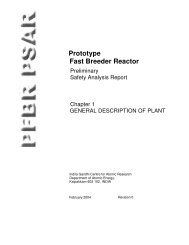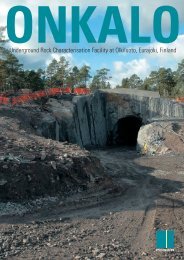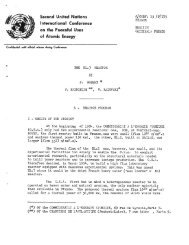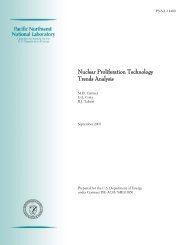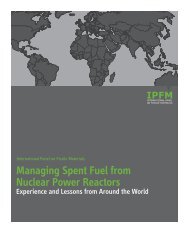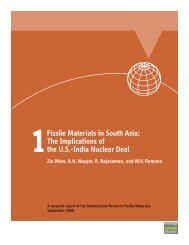Global Fissile Material Report 2009: A Path to Nuclear Disarmament
Global Fissile Material Report 2009: A Path to Nuclear Disarmament
Global Fissile Material Report 2009: A Path to Nuclear Disarmament
You also want an ePaper? Increase the reach of your titles
YUMPU automatically turns print PDFs into web optimized ePapers that Google loves.
The number of nuclear weapon states steadily increased, however, with Britain, Franceand China developing nuclear weapons by the late 1960s. In an effort <strong>to</strong> curb the furtherspread of nuclear weapons, the United States and the Soviet Union, now nuclear“superpowers,” and the United Kingdom negotiated the 1970 nuclear Non-ProliferationTreaty (NPT) with a group of non-weapon states and agreed in Article VI “<strong>to</strong> pursuenegotiations in good faith on effective measures relating <strong>to</strong> the cessation of the nucleararms race at an early date and <strong>to</strong> nuclear disarmament, and on a Treaty on general andcomplete disarmament under strict and effective international control.” A number ofcountries abandoned incipient nuclear weapons programs over the next two decades,but Israel, India and Pakistan stayed outside the Treaty and developed nuclear weapons,as did North Korea, which joined the NPT but later withdrew (Table 2.1).Country Date of first nuclear test Date of accession <strong>to</strong> NPTUnited States July 16, 1945 1970Russia August 29, 1949 1970United Kingdom Oc<strong>to</strong>ber 3, 1952 1970France February 13, 1960 1992China Oc<strong>to</strong>ber 16, 1964 1992India May 18, 1974 –Israel ? 92 –Pakistan May 28, 1998 –North Korea Oc<strong>to</strong>ber 9, 2006 1985 (withdrew 2004)Table 2.1. First nuclear weapons tests by current nuclear weapon states, 1945–<strong>2009</strong>.During this period, there were occasional dramatic proposals for eliminating nuclearweapons. In 1986, Soviet leader Mikhail Gorbachev outlined a three-stage plan fornuclear disarmament within fifteen years. 93 Indian Prime Minister Rajiv Gandhi proposeda similar time-bound program in 1988, envisaging the abolition of all nuclearweapons by 2010. 94In the aftermath of the Cold War, as part of the preparations for the 1995 Review andExtension Conference of the NPT, which was <strong>to</strong> decide whether and for how long <strong>to</strong>extend the Treaty, there were many studies on and reports and statements supportingnuclear disarmament by political leaders and groups of eminent former policy makersand officials. A prominent example was the Canberra Commission of 1996. 95 Thefinal agreement on indefinite extension of the NPT included a consensus decision on“principles and objectives for nuclear non-proliferation and disarmament” which containedthe beginnings of a program of action. This decision included a commitment<strong>to</strong> “the determined pursuit by the nuclear-weapon States of systematic and progressiveefforts <strong>to</strong> reduce nuclear weapons globally, with the ultimate goals of eliminating thoseweapons.” 96In 1996, responding <strong>to</strong> a request from the United Nations General Assembly, the InternationalCourt of Justice, the highest court in the United Nations system, issued aunanimous advisory opinion ruling that Article VI of the NPT required nuclear-weaponstate parties <strong>to</strong> the Treaty “<strong>to</strong> bring <strong>to</strong> a conclusion negotiations leading <strong>to</strong> nucleardisarmament.” 97 At the April 2000 Review Conference of the NPT, the weapons statesagreed in the final document <strong>to</strong> an “unequivocal undertaking … <strong>to</strong> accomplish the26 <strong>Global</strong> <strong>Fissile</strong> <strong>Material</strong> <strong>Report</strong> <strong>2009</strong>



